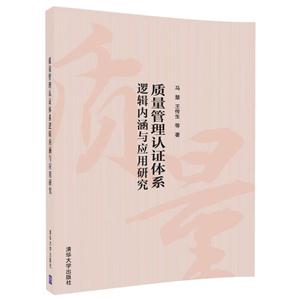质量管理认证体系逻辑内涵与应用研究
本书特色
[
本书是关于质量管理认证体系本质与发展的专著。作者基于长期的研究和教学实践,遵循逻辑应用的规律,从基础理论、核心要素以及可持续提升等方面对质量标准认证逻辑内涵进行研究,以空气和养老质量管理标准为例,诠释研究成果的应用路径,从而提升质量认证的准确性以及效率。全书共7章,内容包括: 概论、逻辑学质量管理应用基础、空气质量标准认证应用分析与逻辑内涵研究、软件质量标准认证逻辑内涵研究、养老管理质量标准认证体系应用研究、京津冀养老管理质量跟踪与评价研究、质量标准评价认证的逻辑内涵与思维导图应用研究。
本书可供从事质量管理标准评价与质量管理的研究人员阅读,也可作为信息管理与信息系统、软件工程、项目管理专业的研究生或本科生的参考书,以满足研究与应用的需要。
]
内容简介
[
本书突出了“规律”的挖掘和“内在要素”的归纳,对质量管理定性与定量分析能力的提升和加强具有重要意义,对开拓逻辑学和质量工程的应用领域也具有重要价值。
]
作者简介
[
马慧 首都经济贸易大学信息学院教授。1993年被评为北京市优秀教师,2014年北京市优秀党员。出版专著《质量评价与软件质量工程知识体系的研究》获北京市哲学社会科学第十二届优秀成果一等奖。《低碳经济治理体系及以云质量管理认证提升资源效率的研究》获北京市哲学社会科学第十四届优秀成果一等奖。长期从事质量工程与质量标准的教学和研究工作。研究重点是:质量管理过程的方法论、质量工程、国际质量标准与能力成熟度评价模型应用。近年来,围绕低碳与质量管理,主持并完成了北京市哲学社会科学项目 “以云技术及评价推动北京信息资源配置效率提升的研究”以及主持北京市自然科学基金项目”基于碳管理能力认证的北京市信息资源碳排放目标实现路径的研究”。其中, 北社科的项目被评为优秀成果项目。申报获批两项发明类专利。教材《软件质量管理与认证方法》为北京市精品教材。王传生 首都经济贸易大学教授,副校长, 博士生导师。教育部管理科学与工程类专业教学指导委员会委员;管理科学与工程学会常务理事,教育部本科教学评估专家。主要从事建设项目管理、建筑工程造价以及企业信息化等领域的教学与研究工作。先后主持和参与国家自然、教育部社会科学基金等项目多项;主持“大同矿区低碳经济发展理论与应用研究”,“大型煤炭企业经营理论与实践”等项目。发表论文几十余篇;出版专著2部;获煤炭工业科技进步三等奖1项、山东省教育厅科技进步一等奖等以及北京市教育教学成果一等奖2项、二等奖2项等。
]
目录
■
目录
第1章概论1
1.1质量管理标准的逻辑内涵思考1
1.2著名质量管理大师的主要贡献以及逻辑关联2
1.2.1质量管理的发展2
1.2.2著名质量管理大师的主要贡献6
第2章逻辑学质量管理应用基础16
2.1逻辑学理论与应用基础16
2.1.1逻辑学基本方法16
2.1.2逻辑学的数学建模方法19
2.2思维导图与逻辑描述22
2.2.1思维导图概述22
2.2.2Visio制作思维导图23
2.2.3MindManager绘制思维导图23
2.3质量管理的经典方法与标准25
2.3.1质量管理经典方法与技术25
2.3.2质量管理的经典标准——ISO质量管理体系研究29
第3章空气质量标准认证应用分析与逻辑内涵研究34
3.1空气质量标准认证体系概述34
3.1.1空气质量管理相关标准概览及其认证体系34
3.1.2ISO系列标准35
3.1.3PAS系列标准37
3.1.4其他空气质量标准39
3.2空气质量标准认证体系应用分析40
3.2.1ISO 14067和PAS 2050技术规范应用比较分析40
3.2.2ISO 14064标准在组织中的应用步骤41
3.3空气质量标准认证体系逻辑思维导图45
3.3.1ISO 40000系列标准思维导图45■质量管理认证体系逻辑内涵与应用研究目录■3.3.2PAS系列标准思维导图48
3.3.3国内相关系列标准思维导图51
第4章软件质量标准认证逻辑内涵研究53
4.1管理信息系统及其逻辑模型53
4.1.1信息流53
4.1.2系统方法54
4.1.3信息系统56
4.1.4管理信息系统概述57
4.1.5信息系统的逻辑描述60
4.1.6新信息系统逻辑模型66
4.2软件能力成熟度模型CMM74
4.2.1CMM的基本结构75
4.2.2二级关键过程域举例——软件项目计划79
4.2.3三级关键过程域举例——组织过程定义85
4.2.4不成熟与成熟软件组织的特征89
4.2.5以CMM提升能力成熟度——以Infosys公司实施软件过程为例96
4.3软件项目开发和产品质量标准认证逻辑内涵研究127
第5章养老管理质量标准认证体系应用研究134
5.1养老管理标准简介134
5.1.1国际养老管理质量标准体系简介134
5.1.2中国养老管理质量标准体系简介140
5.2国内养老管理质量标准的应用案例145
5.2.1上海市社会养老服务体系建设146
5.2.2山西养老服务标准化建设146
5.2.3重庆养老服务体系建设成效147
5.2.4深圳养老服务机构标准化建设试点148
5.2.5山东省养老服务标准化建设149
5.3养老管理质量标准的思维导图及应用逻辑151
5.3.1养老管理质量标准的思维导图151
5.3.2养老管理质量标准的应用逻辑157
第6章京津冀养老管理质量跟踪与评价研究161
6.1京津冀养老管理现状161
6.1.1养老管理161
6.1.2京津冀养老管理现状164
6.2数据驱动的京津冀养老质量跟踪研究167
6.2.1京津冀地区养老服务过程及要求167
6.2.2基于数据的养老机构服务质量跟踪174
6.2.3养老机构服务质量跟踪流程182
6.3京津冀养老质量评价研究186
6.3.1养老机构服务质量评价研究186
6.3.2社区居家养老服务质量评价研究187
第7章质量标准评价认证的逻辑内涵与思维导图应用研究200
7.1质量管理理论及其相关内涵逻辑200
7.1.1中心极限定理与质量管理控制的相关逻辑200
7.1.2软件危机及其风险规避措施的PDCD逻辑212
7.1.3CMM的持续改进分层逻辑215
7.2基于排除归纳逻辑分析的调整不足与调整过度的分析217
7.2.1排除归纳法对问题原因的逻辑分析217
7.2.2调整不足和调整过度逻辑判断流程219
7.3基于排除归纳法的六西格玛DMAIC的分析220
7.3.1DMAIC常规的分析工具的局限和特点220
7.3.2DMAIC的流程图与思维导图225
7.3.3排除归纳法应用于DMAIC能力提升的案例225
7.4基于逻辑分析的质量标准一体化的战略与诊断231
7.5嵌入逻辑分析与思维导图的国际质量管理标准研究237
附录A京津冀养老服务现状及模式调研报告239
A.1调研背景239
A.1.1调研问题的提出239
A.1.2调研方法和思路241
A.2国内外养老服务的现状242
A.2.1国内养老服务现状242
A.2.2国外养老模式现状243
A.3京津冀养老服务基础数据247
A.3.1京津冀基本人口数据分析247
A.3.2京津冀养老服务需求概况249
A.4京津冀养老服务现状249
A.4.1养老服务现状249
A.4.2养老保险现状251
A.4.3医疗保险现状252
A.4.4京津冀养老服务案例254
A.5质量评价261
A.5.1政策法规261
A.5.2服务质量规范262
A.5.3服务质量评定263
A.6推动京津冀养老产业协同发展268
附录B软件项目管理的部分关键要素270
B.1项目管理方面的部分关键过程域270
B.2过程管理方面的部分关键要素说明284
B.3工程管理方面的部分关键要素说明294
B.4支撑管理方面的部分关键要素说明315
参考文献328■ Contents
Chapter 1Introduction1
1.1The logic meaning of quality management
standards1
1.2The main contributions of some famous
management masters and
their logic relationship2
1.2.1The development of quality management2
1.2.2The main contributions of the famous
quality management masters6
Chapter 2Application Basis of Logic in
Quality Management16
2.1Logic theory and its application
foundation16
2.1.1The basic methods of logic16
2.1.2The mathematical modeling methods of
logic19
2.2Mind map and its logic summary22
2.2.1The overview of mind map22
2.2.2Making mind map with Visio23
2.2.3Making mind map with Mindmanager23
2.3The classic methods and standards of
quality management25
2.3.1The classical methods and technology
of quality management25
2.3.2The classic standards of quality
management�睮SO quality management system
study29
Chapter 3Application Analysis and Logical
Connotation of Air Quality Standard
Authentication343.1Overview of air quality
standard certification system34
3.1.1Overview and certification system of
air quality management standard34
3.1.2The ISO 9000 Series Standards35
3.1.3The PAS Series Standards37
3.1.4Other air quality standards39
3.2The application analysis of air quality
standard certification system40
3.2.1Comparative analysis of ISO 14067 and
PAS2050 40■质量管理认证体系逻辑内涵与应用研究Contents■3.2.2The application procedureofISO14064 standard in the
organization 41
3.3The mind map of air quality standard
certification system45
3.3.1The mind map of ISO40000 series
standard45
3.3.2The mind map of PAS series standard48
3.3.3The mind map of domestic relevant
series standard51
Chapter 4Connotation Research in Software
Quality Standard and Certification53
4.1Management information system and its
logic model53
4.1.1Information flow53
4.1.2Systematic method54
4.1.3Information system56
4.1.4Overview of management information
system57
4.1.5Logical description of information
system(Data flow chart Datadictionary)60
4.1.6New information system logic model66
4.2Capability Maturity Model �� CMM74
4.2.1The basic structure of CMM75
4.2.2Examples of second level key process
area��“Software Project Plan”79
4.2.3Examples of third level key process
area ��
“Organizational process definition”85
4.2.4The characteristics of immature and
mature software organizations89
4.2.5Enhancing the capacity maturity with
CMM�睺he implementation of
software development process of Infosys96
4.3The study of the logical meaning of
software project development and
product quality standard 127
Chapter 5Application Research in Quality
Standard and pension System of Endowment
Management1345.1The introduction of elderly
care management standard 134
5.1.1The introduction ofinternational eldly
care management quality standard system134
5.1.2The introduction of domestic eldlycare
quality management standard system140
5.2Examples of domestic eldly care quality
management standard145
5.2.1The development of social eldly care
service system of Shanghai city146
5.2.2The development of eldly care service
standardization of Shanxi province146
5.2.3The achievements of eldly care service
system of Chongqing city147
5.2.4The pilot project of eldly care
service institutionsstandardization of Shenzhen city148
5.2.5The development of eldly care service
system standardization of Shandong
province149
5.3The mind map and application logic of
the eldly care quality management
quality standard151
5.3.1The mind map of eldly care quality
management standard151
5.3.2The application logic of the eldly
care quality management standard157
Chapter 6Quality Tracking and Evaluation on
Beijing�睺ianjin�睭ebei Pension
Management1616.1The current situationof
eldly care management in Beijing�睺ianjin�睭ebei
region161
6.1.1The eldly care service management 161
6.1.2The current situation of eldly care
management in Beijing�睺ianjin�睭ebei region164
6.2The data�瞕riven eldly care
quality study in Beijing�睺ianjin�睭ebei region167
6.2.1The process and requirements ofeldly
care in Beijing�睺ianjin�睭ebei region 167
6.2.2The service quality tracing of eldly
care institutions based on data174
6.2.3The process of tracing eldly care
institution service quality182
6.3The study of eldly care quality
evaluation in Beijing�睺ianjin�睭ebei region186
6.3.1The evaluation study of eldly care
institution service quality 186
6.3.2The evaluation study of community and
home based eldly care service quality 187
Chapter 7Logical Connotation and Mind
Mapping Research in Quality Standard,
Evaluation and Certification2007.1The
quality management theory and its relevant logical meaning200
7.1.1Central limit theorem and its logic
related to quality management control200
7.1.2Software crisis and its risk aversion
measure ��
“PDCD” circle 212
7.1.3The continuous improvinghierarchical
logic of CMM 215
7.2The analysis of inadequate and excessive
adjustment based on
eliminative induction logic217
7.2.1The logical analysis of problem with
eliminative induction method217
7.2.2The application study on quality
problems with eliminative
inductionlogic analysismethod219
7.3Analysis of reasons for Six Sigma DMAIC
Problems Based on Logic
Exclusive Induction220
7.3.1The limitations and characteristics of
DMAIC routine analysis tools 220
7.3.2The flow chart and mind map of DMAIC 225
7.3.3Examples of improving capacity
byapplying eliminative induction logic method i
n the implementation of DMAIC225
7.4integration Strategy implementation and
Diagnosis Based on Quality
Standards Logical Analysis231
7.5Research on the International Quality
Management Standard with Logic
Analysis and Mind Mapping237
Appendix Aresearch report239
Appendix BThe characteristics of key
elements of software projects at different
target levels270
封面

书名:质量管理认证体系逻辑内涵与应用研究
作者:马慧
页数:332
定价:¥89.0
出版社:清华大学出版社
出版日期:2017-08-01
ISBN:9787302480358
PDF电子书大小:120MB 高清扫描完整版
